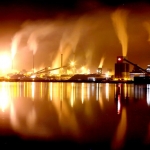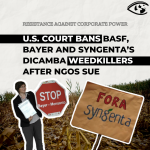ARGENTINA: High Court Provides a Roadmap Against Pollution
The Matanza-Riachuelo river basin, the most polluted in Argentina for more than a century, could begin to see some cleaner waters as the result of an innovative ruling by the National Supreme Court of Justice -- considered a landmark in the history of Latin American environmental law.
In response to a lawsuit by residents affected by the pollution, the Argentine high court this month summoned 44 companies to report on the waste they dump into the Riachuelo River. It also urged the government to present a management plan and convened a public hearing for all parties involved for Sep. 5.
The Matanza-Riachuelo basin is 64 kilometres long. It starts in the west of Buenos Aires province, and upon reaching the capital city, marks its southern border until flowing into the RÃo de la Plata (River Plate). Across the watershed's 2,240 square km live some 3.5 million people, and more than 3,500 industries operate there.
Alfredo Alberti, who lives in one of the area's most vulnerable neighbourhoods, says the Supreme Court ruling has given him hope. "Given the lack of an executive branch that takes charge of the problem once and for all, the Court's proposal is very promising," he told Tierramérica.
The decision not only made an impact amongst those directly involved, but also in the judicial arena. It caused a buzz at a recent Latin American conference on environmental law and policy, held in Buenos Aires, with officials from legal systems across the region.
"Citizens take a stand before the courts to denounce pollution, but what about the government prosecutors?" challenged judge Aideé Vázquez, from the Argentine province of Neuquén. President of the Forum of Judges for the Environment, she told Tierramérica that what the judiciary lacks is training in these issues.
In this context, the Matanza-Riachuelo ruling taught a lesson. "For environmental justice in Argentina and Latin America this is a 'leading case'. The Court has given us a marvelous lesson," said Aida Kemelmajer, a justice on the provincial Supreme Court of Mendoza.
"This is what we judges should be doing, not just writing lovely words, but rather establishing the mode and the deadline for compliance with our decisions," she said.
"It's a landmark; an excellent ruling," said Enrique Peretti, a judge on the Supreme Court of Santa Cruz province. "It incorporates future generations as subjects of law and sets guidelines to follow in those cases."
The Matanza-Riachuelo watershed has been polluted since the 19th century, but in the last few decades the contamination levels turned critical. In April, the Auditor General of the Nation warned of the risk of a "health catastrophe", and the national Ombudsman's Office warned twice about the lack of public policies to govern the matter.
The problem is complicated because it encompasses three jurisdictions. First there is the authority of the national government, which should prevent pollution, but the province of Buenos Aires and the city of Buenos Aires also have responsibility in this area. The Supreme Court established a framework that aims to untangle the conflict of who has jurisdiction over what.
The position of the high court crystallised in a lawsuit filed in 2004 by a group of neighbours against the national, provincial and city governments, and 44 companies for the contamination of the river basin. Among the firms included in the case are Netherlands-based Shell and the German automaker Mercedes Benz.
The ruling resolves to protect exclusively the collective good and returns to the lower court judges the individual demands for eventual damages. Based on this differentiation, the justices considered it their duty to seek recomposition of the damages, and in case they are irreversible, indemnification.
"The improvement or degradation of the environment benefits or harms the entire population because it is a good that belongs to society," states the decision. "From this derives the particular energy with which judges should act to make effective the constitutional mandate to guarantee the right to a healthy environment."
The National Supreme Court said the companies must report in 30 days about the liquid waste they dump in the river, its treatment and if they have the insurance required by environmental law so that they can respond if harm is caused.
The justices also called on the national, provincial and municipal governments to present an "integrated plan" in 30 days with environmental impact statements of the 44 companies; to promote environmental education programs; and to make public all environment-related information.
At the environmental law and policy conference, justice Ricardo Lorenzetti, author of the Supreme Court ruling, recognised that it is the first time the high court has concentrated trusteeship of a collective good like the environment, and that it was done in order to put the matter on the agenda of social debate.
"We need to open this issue to society, because that is the way to raise awareness about a problem and achieve solutions. The laws serve no one if social practice follows other paths," said the justice.
- 204 Manufacturing



